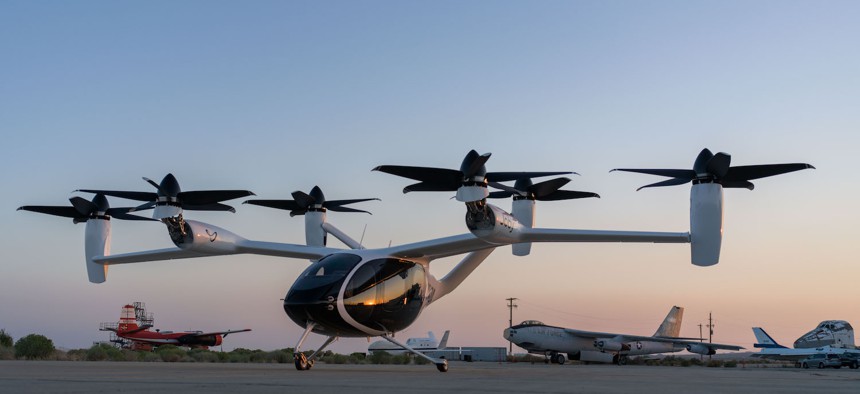
Joby Aviation
Air Force eyes supply missions for its first electric air taxi
Joby Aviation delivered its battery-powered vertical takeoff and landing aircraft to Edwards AFB in California.
The U.S. Air Force will soon begin testing how it will use battery-powered planes to transport people and cargo.
The service announced Monday that Edwards Air Force Base in California received an electric vertical take-off and landing aircraft from Joby Aviation, part of the company’s $131 million contract with the Air Force’s tech innovation arm, AFWERX.
The aircraft holds one pilot and four passengers, can carry a payload of up to 1,000 pounds, and flies at speeds up to 200 miles per hour, said Greg Bowles, head of government affairs for Joby. It will primarily fly missions between 25 to 50 miles, “but the aircraft has the capability to do a lot more than that,” Bowles told Defense One on Friday.
If the Air Force decides to use the aircraft in operations, it could be to fly cargo and personnel short distances in the Pacific. The Joby aircraft could be helpful within “some of the island clusters that don’t have those large ranges,” said Col. Tom Meagher, AFWERX Prime Division Chief.
“Some of the possible long-time use cases are just-in-time parts, people to repair aircraft. Think of it kind of like a hub-and-spoke type of logistics scenario,” Meagher said.
Electric aircraft won’t replace large cargo planes, Meagher said, but could be part of the Air Force’s future logistics fleet.
“I think the best way to think about it is, where can we use a capability like this to complement our existing platforms, when you just need this sort of capability and not a high-end, exquisite platform that has a higher expense at the end of the day?” he said.
The service is interested in electric aircraft because they are much easier to maintain than jets or turboprops. And since the Joby aircraft was designed to operate around cities and for commercial settings, it’s also very quiet, Meagher said.
Current electric aircraft batteries don’t enable the planes to fly for long distances, but Meagher said he expects batteries to improve over time, just as they have for electric cars.
“There's a certain battery energy density and we can get a certain amount of range with those. We expect batteries to continue to prove their energy density over time, just like we've seen on the automotive side,” Meagher said.
And the aircraft can recharge quickly: Bowles said it only takes about seven minutes to fully recharge after a 25-mile mission.
The Edwards team will focus on operational testing and are already working on “experimentation plans” for possible uses for the aircraft, said Maj. Phillip Woodhull, director of the Emerging Technologies Integrated Test Force at Edwards.
“Our security forces are drawing up an experimentation plan to see how the Joby aircraft, or eVTOLs in general, could be used to do things like perimeter security functions, things right now where it would take a large amount of time to drive out to with standard vehicles or if you were to try to use other aircraft would be pretty onerous in the training and maintenance and qualification kind of realm,” Woodhull said.
Joby conducts flight tests on its aircraft completely remotely, with no one on board, but the Air Force said future operations will be piloted. However, Meagher said, the Edwards testing will provide data the service could use for eventual autonomous logistics missions.
The Air Force will continue remotely-operated testing throughout the rest of the year and transition to manned flights next year, Woodhull said.
Edwards will receive another Joby eVTOL aircraft early next year, Bowles said, “and then potentially up to seven more aircraft” later on if the full contract is executed.


